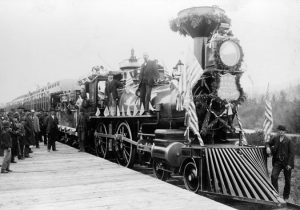
What Europeans were claiming
In 1803, the French emperor Napoleon needed money to rebuild France’s army after the French Revolution. So he agreed to sell France’s land in North America to the newly formed United States. We call this the Louisiana Purchase, but the French sold much more than just the modern state of Louisiana. The land they sold was the whole middle part of the United States. It was land that really belonged to the Mississippians and the Cree people and the Plains people like the Sioux. It was very expensive to buy. But it would have cost much more to buy it from the people who lived there.

Who was really living there
A few years later, in 1810, people in the Spanish part of North America decided to try to get free of Spain, just as the United States had gotten free of England. That’s modern Mexico, Texas, New Mexico, Arizona, California and Nevada. It took a long time. The Mexicans had to make a lot of compromises to get the richest men in Mexico on their side. But finally in 1821 the Mexicans did win independence. France, Austria, and Spain sent troops to try to get Mexico back again. The United States responded in 1823 with the Monroe Doctrine. The Monroe Doctrine told European countries that they should stay out of North America.
By 1836 there were a lot of English settlers in Texas. So Texas decided to leave Mexico and become an independent country. The Texans succeeded in seizing not only the modern state of Texas but also a lot of Apache and Ute land (modern Oklahoma, New Mexico, and part of Colorado). But by 1845 Texas decided to join the United States, and not be independent anymore.

A covered wagon train crossing the Great Plains
Now that the United States had bought all that land in the Louisiana Purchase, the government wanted to get some use out of it by farming it. There weren’t that many Europeans in the United States to do the farming. So new steamships brought millions of settlers from Europe to the coasts of the United States. Many of them went west to find land. Some people walked, and some used covered wagons. As they went west, the English and German and Scandinavian settlers killed Native American people like the Cree and the Chinook. United States soldiers helped them. Or, the settlers and the Army forced people to move to the worst land that was no good for anything. In the 1840s, they forced the Cherokee to leave Georgia and move to Oklahoma.
When these English and German settlers got to the south-west and the Pacific coast of North America, they got into wars with the Mexicans who ruled there. In 1846, England arranged to give the Pacific Northwest, where the Chinook and other people lived (modern Oregon, Idaho and Washington), to the United States. By 1848, the United States army came and took California, Arizona, Nevada, and New Mexico (including a lot of Ute, Californian, Paiute, Navajo, and Pueblo land) while the Mexicans kept only what is now Mexico.

Blackfoot man with horse
At the same time, English settlers were moving across Canada towards the north Pacific coast, fighting against the Blackfoot and other native people. Most of northern North America was united under British rule by 1866 (though the Inuit were still independent people), but in the next year Canada peacefully became an independent country.
Many people from China and other Asian countries came to North America at this time to sell things from their countries like tea, ginseng, or silk. Many Chinese people worked on building the railroads or in the port of San Francisco.
At the same time, enslaved African people were still picking cotton and tobacco in the South. People like Denmark Vesey tried to free the slaves, but it took the Civil War to do it. During the Civil War, in 1863, President Lincoln freed these people, although many of them kept working on the plantations as sharecroppers. Both the people from Asia and the people from Africa were still treated very badly by the European settlers, who kept them from voting or having any part in the United States government.

A railroad train in Fargo, North Dakota in 1883
After the Civil War, the United States sent soldiers to force the Sioux and the Navajo onto reservations. New railroad trains on steel rails carried thousands more settlers across the United States. Many men who had been in the army, and many other people, went north to Alaska, so that many Inuit saw European people for the first time. Then in 1898 the United States began to fight outside the United States to get freedom for other countries, which it could then control.
In 1898, with the Spanish empire collapsing, the United States fought Spain to get control of Cuba and other islands near North America. Then in 1917, with the British Empire collapsing, the United States fought Germany over who would control Europe. In 1940, the United States fought Germany and Japan over who would control Europe and the Atlantic and Pacific Oceans.
After that, the United States fought a long struggle with the Soviet Union, known as the Cold War, for control over the world in general, in places like Cuba, Korea and Vietnam. This ended with the collapse of the Soviet Union in 1991. Since 1991 the United States has been the most powerful country in the world, though other countries, particularly China, are quickly catching up.
Learn by doing: visit a slave plantation, or a pueblo, or a Native American reservation
American History
Bibliography and further reading about North American history: